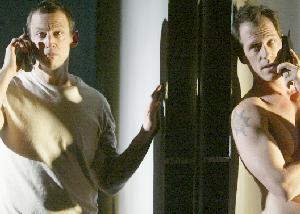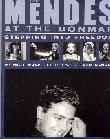SEARCH CurtainUp
REVIEWS
FEATURES
NEWS
Etcetera and
Short Term Listings
LISTINGS
Broadway
Off-Broadway
BOOKS and CDs
OTHER PLACES
Berkshires
London
LA/San Diego
DC
Philadelphia
Elsewhere
QUOTES
On TKTS
LETTERS TO EDITOR
FILM
LINKS
MISCELANEOUS
Free Updates
Masthead
NYC Weather
Splatter Pattern (or, How I Got Away With It)
Whatever you write about, look for the motive under the motive--- Tate's admonition to his writing students can also prove useful to Spatter Patter audiences as they try to figure out Tate's and Dunn's journey through a maze of despair and suspicion. |

Peter Frechette & Darren Pettie
(Photo: Joan Marcus)
|
There's certainly no shortage of noir-ish twists in Neil Bell's new play, Spatter Pattern, being given its world premiere at Playwrights Horizons' 99-seat theater. The sensational, unsolved murder and the intersecting lives of two troubled strangers in a city (New York) full of lost souls, remind one of novelist Paul Auster's mysterious New York Trilogy. This resemblance is underscored by the smart dissonance of Michael Greif's direction and Mark Wendland's constantly changing but consistently joyless interior and exterior scenery. Yet, unlike Auster, who tends not to bother to make sense of the clues he spatters around, Bell does connect the dots between his characters' high tension random meetings and conversations. The murder mystery may not be wrapped up in a neat package, but by the time the play ends, the emotional patterns that shape the two focal characters, Edward Dunn and Marcus Tate, are clearer.
If you've seen Peter Frechette, you won't be disappointed in his Dunn -- a man who's been trying to come to grips with being alone after a twenty-three-year long relationship ended with his partner David's death from lung cancer. He displays his usual knack for being funny even as he is obviously crushed by sorrow. A scene in which Dunn finally collects David's remains or "cremains" is a particularly telling example of Frechette's sad-funny persona, as well as the play's overall sense of black-tinted humor. Those "cremains" also provide Dunn with a powerful monologue and pull the play out of the lag that sets in about two-thirds of the way through a plot that has heretofore arced as fast as a propeller.
Darren Pettie as Tate convincingly has us teetering between thinking it possible or impossible that he killed a student who threatens to expose the manufactured war stories with which he regales his classes in order to grab their attention. While there are only two other actors in the cast, the stage is filled with enough characters to be a reasonable facsimile of a teeming metropolis. Deidre O'Connell and John Lavelle bring them all to vivid life.
O'Connell is especially good as Duff's tough-as nails agent but also hits the mark as the student who, after confronting Duff about his classroom lies tells a friend how she got away with it (this is just one of that title tag line's several loaded meanings). Lavelle shines as a detective determined to nail Duff. The two multiple role players riotously team up as the managers of the establishment where Dunn goes to collect his lovers' ashes. These and other portraits help to create the pattern that brings Dunn and Tate to the same dead-end fork in their life's path -- a fork which leads them to join forces as a means dealing with the losses fate has sent their way.
The use of a few panels to achieve constant scene shifts is ingenious though somewhat too frenetic and self-consciously theatrical. Eventually, all the hyper-active blackouts contribute to the already mentioned bump in the dramatic pace when some of what's said begins to sound repetitious and you're ready to decide who's guilty of what. But then there's Frechette's closing monologue, so irresistibly poignant that he gets away with it being a bit syrupy, as Spatter Pattern gets away with being a very human story as well as an entertaining stage noir.
|
SPATTER PATTERN, (or How I Got Away With It)
Written by Neal Bell Directed by Michael Greif Cast: Peter Frechette (Dunn), John Lavelle (Detective, Mancheski, and others), Deirdre O'Connel (Selma, Andrea, and others), and Darren Pettie (Tate) . Set Design: Mark Wendland. Costume Design: Miranda Hoffman Lighting Design: Kevin Adams Sound Design: Jill B.C. DuBoff Original Music: Michael Friedman Running time: 90 minutes without an intermission Peter Jay Sharp Theater, Playwrights Horizons, Theater Row on 4nd Street www.playwrightshorizon.org or 212/279-4200 9/30/04 to 10/31/04; opening 10/10 Tues through Fridays at 7:30; Saturday at 2 and 7:30 pm and Sundays at 2 and 7pm. Tickets $38-- student rush for $12, with valid ID, cash only, day of performance, subject to availability Reviewed by Elyse Sommer based on October 9th press performance |

Retold by Tina Packer of Shakespeare & Co.
Click image to buy.
Our Review

Mendes at the Donmar
Our Review

At This Theater

Leonard Maltin's 2003 Movie and Video Guide

Ridiculous!The Theatrical Life & Times of Charles Ludlam

6, 500 Comparative Phrases including 800 Shakespearean Metaphors by CurtainUp's editor.
Click image to buy.
Go here for details and larger image.



